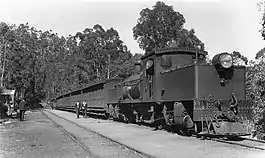| Mundaring Weir branch | ||||||||||||||||||||||||||||||||||||||||||||||||||||||||||||||||||||||||||||
|---|---|---|---|---|---|---|---|---|---|---|---|---|---|---|---|---|---|---|---|---|---|---|---|---|---|---|---|---|---|---|---|---|---|---|---|---|---|---|---|---|---|---|---|---|---|---|---|---|---|---|---|---|---|---|---|---|---|---|---|---|---|---|---|---|---|---|---|---|---|---|---|---|---|---|---|---|
 A WAGR Ms class Garratt locomotive with a passenger train at Mundaring Weir, 1930s. | ||||||||||||||||||||||||||||||||||||||||||||||||||||||||||||||||||||||||||||
| Overview | ||||||||||||||||||||||||||||||||||||||||||||||||||||||||||||||||||||||||||||
| Status | Closed | |||||||||||||||||||||||||||||||||||||||||||||||||||||||||||||||||||||||||||
| Owner | PWD - then WAGR | |||||||||||||||||||||||||||||||||||||||||||||||||||||||||||||||||||||||||||
| Termini | ||||||||||||||||||||||||||||||||||||||||||||||||||||||||||||||||||||||||||||
| Service | ||||||||||||||||||||||||||||||||||||||||||||||||||||||||||||||||||||||||||||
| Type | Heavy rail | |||||||||||||||||||||||||||||||||||||||||||||||||||||||||||||||||||||||||||
| System | WAGR | |||||||||||||||||||||||||||||||||||||||||||||||||||||||||||||||||||||||||||
| Operator(s) | PWD - then WAGR | |||||||||||||||||||||||||||||||||||||||||||||||||||||||||||||||||||||||||||
| History | ||||||||||||||||||||||||||||||||||||||||||||||||||||||||||||||||||||||||||||
| Opened | 1 June 1898 | |||||||||||||||||||||||||||||||||||||||||||||||||||||||||||||||||||||||||||
| Closed | 14 November 1952 | |||||||||||||||||||||||||||||||||||||||||||||||||||||||||||||||||||||||||||
| Technical | ||||||||||||||||||||||||||||||||||||||||||||||||||||||||||||||||||||||||||||
| Number of tracks | Single | |||||||||||||||||||||||||||||||||||||||||||||||||||||||||||||||||||||||||||
| Track gauge | 3 ft 6 in (1,067 mm) | |||||||||||||||||||||||||||||||||||||||||||||||||||||||||||||||||||||||||||
| ||||||||||||||||||||||||||||||||||||||||||||||||||||||||||||||||||||||||||||
The Mundaring Weir Branch Railway was constructed from Mundaring, Western Australia to the site of the Mundaring Weir, and opened on 1 June 1898.[1]
Overview
One of the rail lines constructed by the Public Works Department in the early 20th century, the line was specifically built for the construction of the weir,[2] and incorporated a zig zag.[3]
The line taken over by the Western Australian Government Railways some years after its construction.[4]
The branch was popular for picnics and excursions to the weir between the 1920s[5] and 1940s.[6] The current route of Mundaring Weir Road crosses the formation of the railway at two locations before the site of former No 2 Power station, and is parallel from the Weir road junction to the Mundaring Weir Hotel.
Difficulties
Due to the steep grades down to Mundaring Weir, a limited range of locomotives were permitted to be run on the line.
In the 1940s the declining availability of Msa Garratt steam locomotives affected the number excursion trains that could run to the weir. This was a particular problem during times when the weir overflowed, because the Msa Garratt seemed to be the only engine in service capable of negotiating the steep gradients.
Due to lack of activity on the line in the early 1950s it was closed on 14 November 1952. A bill to officially close the line passed state parliament in December 1952.[7][8]
Services on the connecting line, Mundaring Branch Railway, ceased traffic on 23 January 1954. The line was closed by parliament in 1966.[9]
Different proposals since 1966 to resurrect the railway line as a tourist attraction have not materialised.
Stopping places
The branch commenced to the east of the Mundaring Railway Station yard.
- Mundaring Weir
- Kardo Mordo, adjacent to the Mundaring Weir Hotel and Mundaring Weir Mechanics' Institute[10]
- Portagabra (near the current roundabout intersection turnoff to the Kookaburra Outdoor Cinema). Portagabra was the transfer station for cement railed from the Rivervale cement plant for the works to increase the height of Mundaring Weir in 1948.[11]
- O'Connor, opened as No. 2 Pumping Station in 1922. Renamed O'Connor c.1930.
- Wonyil, west along the track where the line formation separates from the Mundaring Weir Road)
See also
References
- ↑ Mundaring Primary School (W.A.) (2007), Down memory line : a history of the Mundaring to Mundaring Weir spurline, 1898–1952, Mundaring Primary School, retrieved 23 December 2013
- ↑ Gunzburg, Adrian; Austin, Jeff; Rail Heritage WA; Gunzburg, Adrian; Austin, Jeff (2008), Rails through the bush : timber and firewood tramways and railway contractors of Western Australia (2nd ed.), Rail Heritage WA, ISBN 978-0-9803922-2-7
- ↑ "Mundaring Weir Railway". The Swan Express. Vol. IV, no. 7. Western Australia. 16 January 1904. p. 3. Retrieved 1 September 2018 – via National Library of Australia.
- ↑ "MUNDARING WEIR RAILWAY". The Swan Express. Vol. IX, no. 50. Western Australia. 22 October 1909. p. 3. Retrieved 5 November 2016 – via National Library of Australia.
- ↑ "MUNDARING WEIR OVERFLOW". The Daily News. Perth: National Library of Australia. 11 August 1926. p. 6 Edition: HOME (FINAL) EDITION. Retrieved 23 December 2013.
- ↑ Gunzburg, Adrian; Woodland, E. W. Port Honey & Company's timber tramway; Australian Railway Historical Society. Western Australian Division (1968), The Mundaring Weir railway, Australian Railway Historical Society, W.A. Division (Inc.), retrieved 23 December 2013
- ↑ "Bill To Close Mundaring Weir Railway". The West Australian. Perth, WA. 15 October 1952. p. 11. Retrieved 23 December 2013.
- ↑ "Parliament Debates Eighty-Two Bills". The West Australian. Perth, WA. 13 December 1952. p. 9. Retrieved 14 May 2017.
- ↑ "Mundaring". The Swan Express. Midland Junction, WA. 28 January 1954. p. 8. Retrieved 14 May 2017.
- ↑ "Mundaring Weir". The Swan Express. Midland Junction, WA. 25 June 1920. p. 5. Retrieved 14 May 2017.
- ↑ "Cement For Weir Wall Bulk-Handled By Rail". The Daily News (Perth, WA. Perth, WA. 13 April 1948. p. 5. Retrieved 14 May 2017.
Further reading
- Elliot, Ian (1983). Mundaring – A History of the Shire (2nd ed.). Mundaring: Mundaring Shire. ISBN 0-9592776-0-9.
- Gunzburg, Adrian.(1968) The Mundaring Weir railway, Perth. Australian Railway Historical Society, W.A. Division (Inc.) Copy held at Battye Library bound with: Port Honey & Companys̀ timber tramway by E.W. Woodland.
- Watson, Lindsay (1995). The railway history of Midland Junction : commemorating the centenary of Midland Junction, 1895–1995. Swan View, W.A: L & S Drafting in association with the Shire of Swan and the Western Australian Light Railway Preservation Association. ISBN 0-646-24461-2.